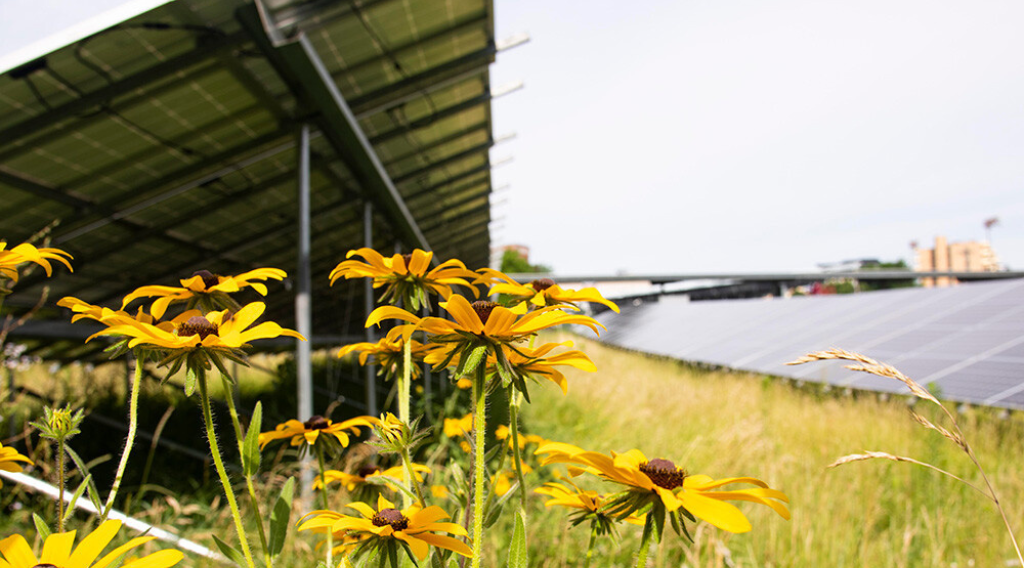 The third case study is now available from a groundbreaking project to establish the first science-based stormwater and water quality standards for solar farms. The Great Plains Institute is helping lead the Photovoltaic Stormwater Management Research and Testing (PV-SMaRT) project along with the National Renewable Energy Laboratory, Fresh Energy, and the University of Minnesota. PV-SMaRT is funded by the US Department of Energy’s Solar Energy Technology office.
The third case study is now available from a groundbreaking project to establish the first science-based stormwater and water quality standards for solar farms. The Great Plains Institute is helping lead the Photovoltaic Stormwater Management Research and Testing (PV-SMaRT) project along with the National Renewable Energy Laboratory, Fresh Energy, and the University of Minnesota. PV-SMaRT is funded by the US Department of Energy’s Solar Energy Technology office.
GPI is working with Fresh Energy to develop a series of case studies highlighting three of the five PV-SMaRT study sites. Pine Gate Renewables’ Eagle Point solar site in Medford, Oregon, is one of the PV-SMaRT project sites and the focus of the third and final case study.
A few takeaways from the case study in Medford, Oregon:
- Solar projects must adapt to each state’s stormwater permitting requirements that meet the needs of a state’s ecosystems and water quality priorities.
- Pine Gate Renewables’ Eagle Point solar site shows the national implications of the scientific findings, best practices, and final runoff calculator (which will be publicly available).
- The modeling results show how most solar sites can be designed to significantly decrease stormwater runoff compared to agricultural land uses.
The solar installation generates 13 megawatts of electricity and was one of the first sites in Pine Gate Renewables’ SolarCulture Initiative. The initiative promotes sustainable agriculture while collaborating with landowners to preserve native plants and animals on agricultural land hosting solar installations.
Brian Ross, vice president at GPI, reflects on the benefits this site has provided the PV-SMaRT project, “The Eagle Point site in Oregon gives us a West Coast example to demonstrate the national implications of the scientific findings, best practices, and final runoff calculator. The federal government generally delegates administration of stormwater permitting, required under the Clean Water Act, to the individual states. While based on a common foundation, state stormwater permitting processes will reflect each state’s unique ecosystems and water quality priorities, and solar projects must adapt to these differences. Looking at the Eagle Point site further demonstrates the applicability of the science across different regulatory and permitting regimes.”
To develop the site into a pollinator-friendly site populated by native grasses and flowers, Pine Gate assembled various entities to achieve their vision, including Regenerate, a landscape design consultant, and Understory Consulting, a nonprofit focused on ecological consulting and restoration. This group has turned lands used for dairy farming into a restored prairie. The prairie hosts a few dozen honeybee hives and allows for seed collection, which aids in increasing the diversity and availability of native plants in the area.
At this solar site, the soil type is classified as clay; Eagle Point has the densest soils of the five PV-SMaRT sites. Clay soil inhibits infiltration of stormwater and therefore was expected to have higher rates of runoff. Monitoring the site as a part of the PV-SMaRT study has shown that more infiltration occurred at the site than was expected. This was due to the presence of deeper root systems, which lessens the density of the soil and aids in infiltration of stormwater.
The University of Minnesota team has developed a stormwater runoff calculator from the field research and modeling completed on this site and the other four sites across the nation (New York, Georgia, Minnesota, and Colorado). The modeling results demonstrate that, under most site conditions, if soils are not compacted and deep-rooted vegetation is established, solar farms result in significant decrease in runoff compared to agricultural land uses.
The calculator is publicly available for use by local and state regulators, solar industry contractors and developers, and water quality advocates. Contact Brian Ross at [email protected] for access to the stormwater runoff calculator. GPI is modifying the interim best practice guide completed last Fall to accompany the calculator and reflect the final modeling results.
Read the case study and learn more about the Eagle Point site, the research process, the site benefits, and stakeholder feedback on Fresh Energy’s website.
More about this groundbreaking project can be found on the National Renewable Energy Laboratory’s website.


